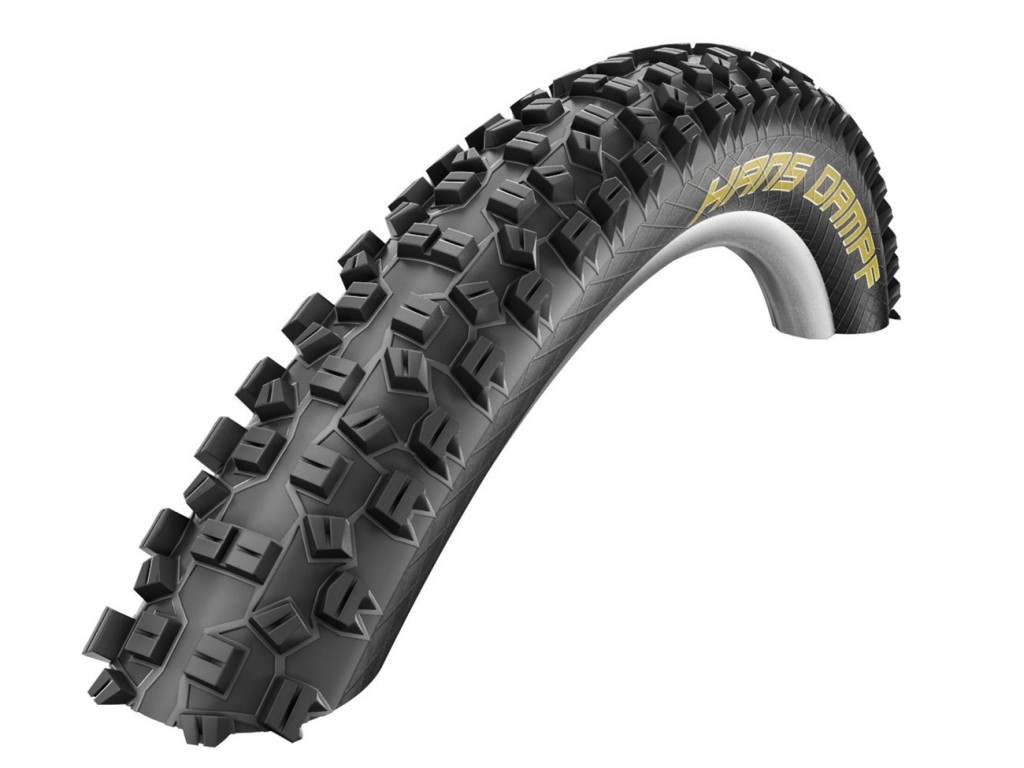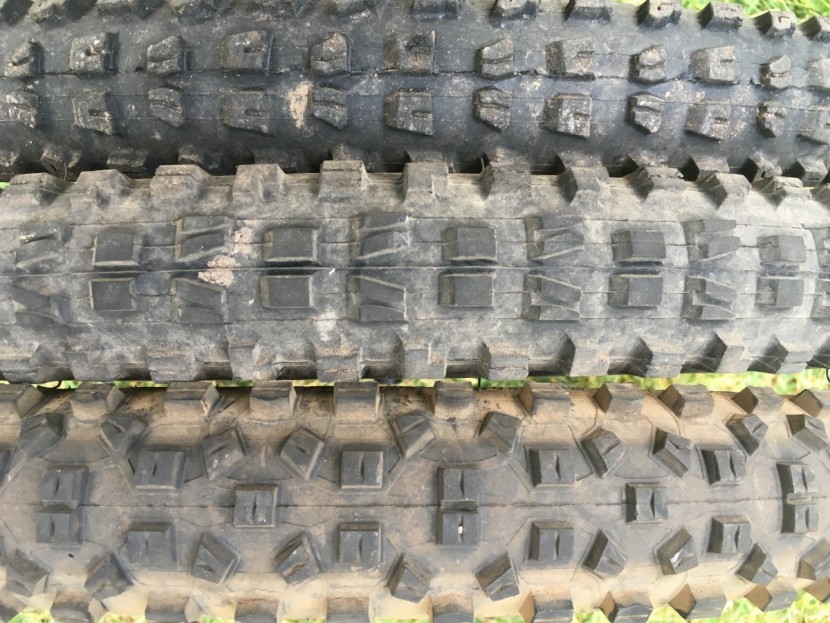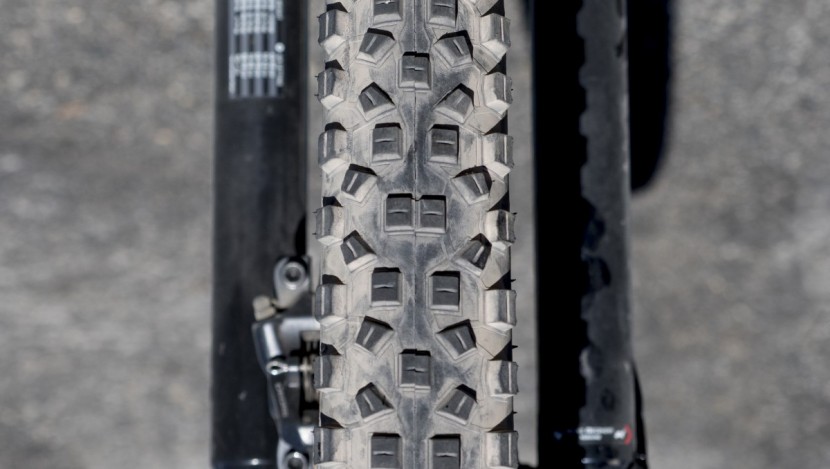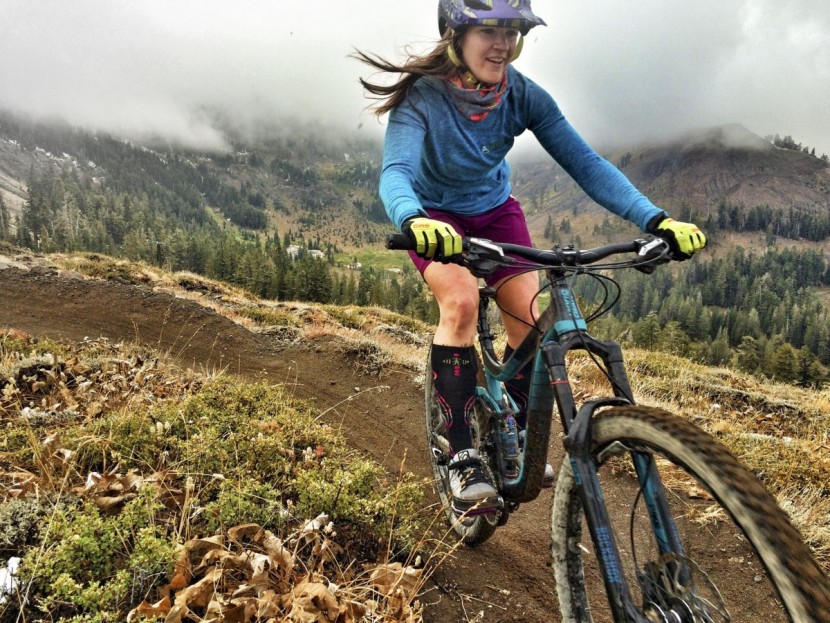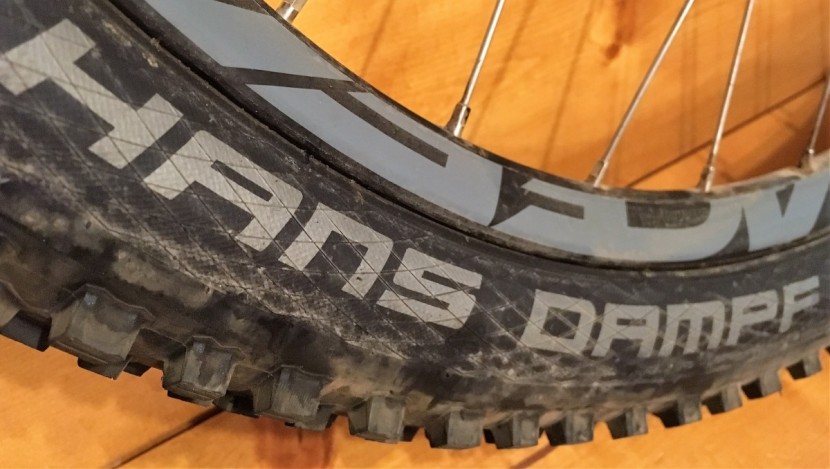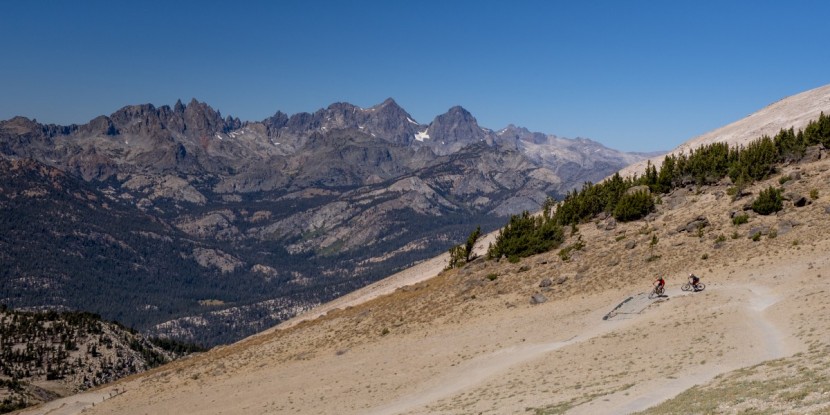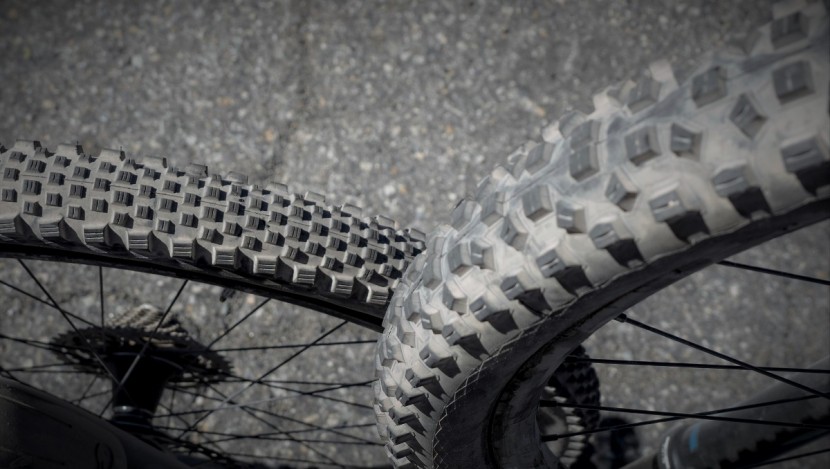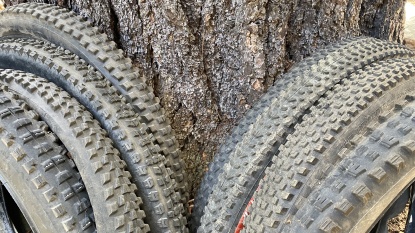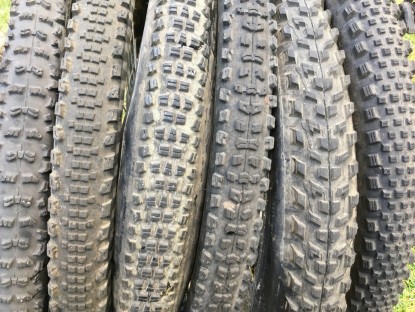Schwalbe Hans Dampf 2.35 TrailStar EVO Review
Our Verdict
Our Analysis and Test Results
Our Top Pick Award winner surprised us in more than a few ways. We expected the soft TrailStar rubber compound to wear out quickly and hold us back with a high rolling resistance. It didn't. The blocky, unramped, large knobs should have buzzed and complained on harder surfaces and had us reaching our lactate thresholds prematurely pushing harder to maintain forward momentum. Not so much. This rounded, high-volume tire took on slanted off camber surfaces like no other tire in the test. Square-shaped tires, including our Editors' Choice Maxxis Minion and the WTB Vigilante, can sometimes feel tippy when traversing, but not this tire. With that said, it won't rail a corner like those tires can but instead in hits apexes in a controlled drift. It can be fun for some and odd feeling for others but this “Jack of all trades” might just completely change your riding style and smash preconceived notions about how a tire is supposed to perform.
Cornering
What set this tire apart from the rest of the pack is its even cornering feel. Knobs are spaced across the tire so that there are no gaps or channels like many other tires we tested. The center tread is a three-row-wide pattern of alternating, siped, blocky knobs. There is a lone center knob, two that straddle the midline, and two more that creep towards the transitional zone. Trapezoidal knobs are placed at an angle in the transition zone, which lead to larger, aggressive shoulder lugs. The knobs get progressively taller as you work away from the 3-mm center knobs, to the 4-mm transitional knobs, to 6-mm on the edges. The symmetrical tread pattern allows the tire to be run in either direction.
From the cockpit of the bike looking down at the tire, you'll notice the profile of the tire appears a bit more rounded or hemispheric that some other tires. The tire felt a little drifty to us. Some riders may like this feel while others may prefer more edge bite. On looser corners, such as those with a firm base covered in gravely rock, the drift was more apparent. It was however, predictable. Our advice is to simply go with it as it was easily controllable. The tire always found its footing and hooked up nicely just in time to pedal hard out of the turn. The round profile smooths into hard packed corners on good dirt.
The lack of transitional feel makes corners that are armored with pavers feel especially grippy. Again, the distinct edgy feel that other tires have is simply absent here. On the rare occasion during our California summer when things did get muddy, we were prompt to reach for another set of skins. The rest of the time, the softer Trail Star rubber compound, round profile, and soft cornering knobs felt right at home on granite rock slabs and highly technical terrain. The WTB Vigilante was the only other tire that really resembled the front tire cornering characteristics of this tire but we would really call it drifty. It just broke loose once leaned over far enough.
The Continental Mountain King drifted too, but not in the controlled, enjoyable way the Hans Dampf did. Rather, it drifted due to an exceptionally large blank zone between the center tread and side knobs. Once overcome, the Mountain King carved corners hard. In very loose terrain, despite a very different tread pattern the Michelin Wild Grip'r took a smooth predictable line just like the Schwalbes where others seemed to have a mind of their own. The Hans Dampf really was unique and drew few comparisons to other tires in the test as it pertained to cornering.
Pedal Traction
The grip of the Trail Star version on this tire is immense. Where some other rubber compounds had us ping-ponging through rock gardens, the Hans Dampf gripped it and ripped it. Although run on the front wheel for the majority of our test, when we threw it on the back wheel we were equally impressed. In fact, the even, predictable nature of the tread profile make this tire a great choice for less experienced riders that may shy away from leaning hard into corners.
On rock, where a more square profile tire can feel like it's barely hanging on when tipped on edge, this rounded tire smears and grips. It might take a few rides to dial in this tire's perfect pressure setting. Pump too much and you're left riding high on the crown tread without much engagement from the rest of the tire. Too low and we had problems burping and flatting the tire. Heavier or aggressive riders not worried about a weight penalty might opt for the Super Gravity casing (not tested) as it might offer more sidewall support for descent-focused riding.
The Black Chili compound found on the Continental Mountain King and the soft 42A durometer rubber on the Specialized Butcher crawled over rocky, slabby terrain with confident footing. Same for the WTB Vigilante. The rounded profile of this tire and even tread felt more stable when weighted from the side than the Michelin Wild Grip'r which had high profile side knobs that felt squeamish traversing hard ground.
Braking Traction
The softer rubber and siped knobs make grabbing a handful of brake when things get spicy a predictable affair. Dumping speed without locking up the tire is a bit more controllable, especially when run on the rear compared to some semi-slicks. On the front, the tire maintains it forgiving, predictable ride character even when pressed to scale things back under braking stress. We found that other tires can be skatey when throttled back and not ridden at the tolerance of their aggression threshold.
By contrast, this tire may appeal to a broader range of rider abilities given that it isn't so quick to punish a rider that isn't always willing, able, or desiring to put the hammer down every second of every ride. The soft rubber of the Specialized Butcher provided traction and made braking predictable. Horizontal treads that run perpendicular to your line of descent make the WTB Vigilante a tremendous braking tire as well.
Rolling Resistance
We were surprised at how well this tire got to rolling without putting up such a fuss. With the softer Trail Start compound we chose and the siped, blocky tread pattern, we expected a bit more drag. The tire is unusually quiet as well, which we attributed to the soft rubber that molds easily into uneven terrain. On pavement you can feel the soft, pencil eraser feeling of this tire. When other squared, blocky tires are rocked back and forth with hard out-of-the-saddle pedaling, a dragging feeling can be quite evident. That feeling was all but absent with the Hans. Rolling resistance and grip was consistent; when the bike was slanted away from you, riding terrain fell away from underneath your tires, making off-camber rock slabs feel much more secure. These tires feel super smooth underneath you, especially on firm ground, compared to something like the Michelin Wild Grip'r, Continental Mountain King, or Maxxis Minion DHF.
Longevity
We took a gamble here and we think it paid off. Tested primarily in the front, we felt justified in selecting the softer version of this tire in hopes it would pay dividends with enhanced grip. Given that a front tire is not subjected to the pedaling forces a rear tire must endure, the lifespan tends to be a bit longer. While we didn't compare it to the same tire with a harder Pace Star compound, the performance we experienced was first rate. We've been smearing these knobs into Sierra Granite for months and the tread is still holding up nicely. The 67 TPI casing provides two layers of sidewall protection with an additional third ply underneath the tire's tread. The cool diamond patterned Snakeskin is laminated to the sidewall for additional rough and scuff protection. The Snakeskin casing did it's job of shrugging off some big hits, although it didn't feel quite as firm as of the other offerings on the Maxxis Minion DHF or Specialized Butcher Grid.
Installation
This was one of the easiest tires to install in the whole test, second to the WTB Vigilante and WTB Trail Boss. Schwalbe tires just have a supple feeling to them and as a result seem to slip onto wheels that much easier. The soft rubber compound was easy to grab in our hands, which makes pushing that last few inches of bead over the rim a heck of a lot easier.
Best Applications
Riding slick rock in Moab or Gooseberry Mesa? How about buffed-out single track in Sun Valley or Fruita? Bombing downhill in deep Pumice at Mammoth or pedaling up to charge down the technical descents of Lake Tahoe. Where isn't this tire good? If it's been pouring rain and the type of day that will end with a mud streak extending from the back of your neck down to your tailbone, grab something else. Otherwise, eliminate the guesswork and get your hands on a Hans Dampf.
Value
They don't give Schwalbes away and after Uncle Sam gets his share, this tire will set you back about a Benjamin. It can often be a struggle to decide if something is worth the extra cash, but in this case, we think a few rides will erase any memory of that extra $20 you spent. If you're still grappling with the cost, just skip happy-hour once this month, ride your bike instead, and quit crying about it.
Conclusion
Few other tires in this test were so widely embraced by so many different riders. More aggressive testers unafraid to charge into corners and ride out the drift enjoyed the unique ride. Less experienced riders gained confidence from the predictable and forgiving feel that didn't punish a less aggressive style. The sandy, dry, and rocky trails of Lake Tahoe, where a large portion of our testing was conducted, seemed to be the perfect home for these tires. Locations that see a lot more precipitation are probably better suited to a more aggressive tread pattern. Other than that, the Hans Dampf or “Jack of all trades” is a solid pick for a wide variety of riders and locations.


